By Father P.J. O'Connor
1937
Below, on this page are pages 54-79. For the rest of the book go to:
PAGE 54
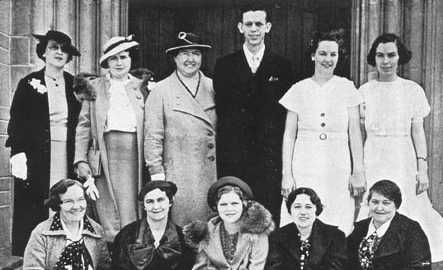
CONFRATERNITY OF THE MOST BLESSED SACRAMENT
Top Row: Mrs. James Brady, Mrs. Eugene Dyer, Mrs. Norman Brady, Mr. Walter Strathman, President; Miss Mary Ellen Griffin, Miss Gloria Duggan.
Front Row: Mrs. William Menner, Mrs. Al. Moellenbeck, Vice-President; Mrs. George Shaffrey, Vice-President; Mrs. Morgan P. Foley, Vice-President; Mrs. Thomas Meehan.
Confraternity of the Blessed Sacrament
To foster and develop devotion to Our Lord in the Holy Eucharist the Confraternity of the Blessed Sacrament has members young and old, of both sexes. Encouraging frequent Communion and attendance at Processions and the like, are these officers: Mr. Walter Strathman, President; Mrs. George Shaffrey, Vice-President; Mrs. Morgan P. Foley and Mrs. A. P. Moelenbeck, Assistant Vice-Presidents.
St Vincent de Paul Society
The first branch of St. Vincent de Paul Society in St. James Parish was established February 20, 1898. Judge Dillon, President of "Upper Council"; W. J. Kinsella, President of New Cathedral Council, and Freeland R. Dunn, Secretary of same, were present at the installation of officers.
The meeting was held in the Rectory. Rev. Edmond A. Casey opened the meeting with prayer and the following officers were duly installed: Rev. E. A. Casey, Spiritual Director; Henry Hart, President; James P. O'Gorman, Vice-president; William O'Gorman, Secretary; Charles Ehle, Treasurer; Charter members, P. J. Connors, John P. Dolan, Henry Lang, John J. O'Gorman, John Merriman, Edward Connors. Mat McLaughlin.
The conference met on Sunday after the late Mass till June 5, 1899, when it was decided to hold meetings the first and third Mondays of each month at 8 P. M., about this time Will O'Gorman was appointed President. The meeting hour was changed again may 7, 1901, to the first and third Tuesdays. There was a gradual lack of interest, the treasury had only a balance of $1.00 and the Council died of neglect. Father Casey said what killed the Council was "an old shark up on Wade Avenue, who lived off the Council for a year and at last ate it up bait, hook, line, sinker and pole."
The failure of the Council in this instance evidently arose from a wrong conception of what a St. Vincent de Paul' Society should be. Many of the older Councils had a very narrow idea of the range of activities to be undertaken, and it was difficult for a Spiritual Director to change their attitude in this respect. They thought of St. Vincent de Paul Society as an organization for passing the hat and distributing alms.
They kept to "cases' and presumed their duties were discharged when they had attended to applicants for physical help; they apparently took little or no interest in the spiritual welfare of others; that there were
PAGE 55
children of the well-to-do who had not made their First Communion was no affair of theirs nor were they specially interested in the other corporal and spiritual works of mercy. As a result members had nothing to report when they were not assigned to a case and lost interest in meetings. The last reports made by the Secretary show that for several months no one attended meetings except the officers and there were few "cases" and no funds.
There is the same danger today to all St. Vincent de Paul branches that confine their reports to cases of relief. The General Council and other Relief Agencies attend to distribution of State and Federal Relief and there are only few cases being cared for by the local branch. The sermon given by Archbishop John J. Glennon an May 3, 1937, at the Catholic Charities Pageant in the Municipal Auditorium, St. Louis, brings out the point very clearly.
"The idea and the scope of charity is misunderstood by many Catholics, and is generally misunderstood by non-Catholics," the Archbishop said. "Charity is generally regarded as merely 'giving alms,' handing out a little money as we go along. But that is a very narrow interpretation. The church says charity is one of the three great virtues: faith, hope and charity.
"The meaning of charity in the Latin is 'love.' By the virtue of charity we are bound in the love of God. Charity is loving your neighbor, for the love of God, and doing for him what love should do when that love is of divine origin, remembering our blessed Lord is the highest exemplar of that charity. He expended the great charity of His heart for the sick, the poor, the sorrowful, the dead.
"As soon as you start measuring your charity, it ceases to be a virtue and becomes a science.
"Philanthropy is done 'for the love of man.' It is of humanity, it belongs to the earth, It does not take into consideration any higher purpose or homage. I do not criticize this method of giving. It is excellent in its way, but it is not charity. It has no supernatural motive. It accomplishes much good in the health and welfare of the community, but it lacks a soul.
"We come to a new word in our midst -- 'relief.' This 'relief' is obtained from the Federal Government or the state government or the municipality. It is intended to help the poor and unemployed, tiding them over from day to day. It is not even 'philanthropy.' It is simply a temporary help. It is not a thing mentioned in the Constitution. It has become necessary because of conditions.
"But whatever may be done by legislation, and whatever may be the generosity of the philanthropist, there will still be needed charity which will care for the poor, the sick, the aged, the orphan and the homeless man. There will always be a need for Charity that has the divine stamp as long as human society exists."
St. Vincent de Paul Society Reorganized November 24, 1931
The acute depression that left millions all over the country without employment in 1931 and the succeeding years gave St. Vincent de Paul Society a new special interest in the poor. Community drives, State and Federal Government relief found the volunteer worker of the St. Vincent de Paul type was as good, if not better, than the paid agent and to them was entrusted, wherever a local branch existed, a large distribution of funds. St. James Parish immediately began to reorganize and on November 24, 1931, the branch came back to existence. At a meeting in the cafeteria of the school the following officers were installed. Rev. P. J. O'Connor, Spiritual Director; W. E. McCann, President; Jos. J. Crotty, Vice-President; John J. Kelly, Secretary, and W. J. Bosche, Treasurer.
At this and the few following meetings the following were enrolled as members: C. P. Billings, Wm. Henne, John C. Houlihan, Wm. Jones, Walter Lambert, Edw. L Loyet, A. H. Mudd, John J. Newport, Roy H. Obermann, J. P. O'Gorman, R. E. Pierce, P. J. Regan. C. L. Thompson, Geo. H. Wiber, Frank C. Ebenreck, Ollie Dolan, D. J. Murphy, Harry A. Huger, Geo, Frey, Chas. Jones, F. W. Wethmar, Chas. W. Klasek, J. E. McLaughlin, Arthur E. Pahl, M. C Coad, Edward Cody, W. H. Henkel, M. Scherzinger, M. J. Doherty, Dr. Bowdern, Joe Long, Frank Piestrup, and Daniel F. Sheehan.
Attendance at meetings continued for Several months and there was not lack of interest until the General Council found it necessary to make its own investigation through district workers who were especially educated in social service and paid for their services. This reduced the number of cases and as the old tradition of confining reports to actual cases of need returned, members believed there was nothing for them to do and began to lose interest. Father O'Connor, the Spiritual Director of the Branch, made a vigorous effort to interest members in the spiritual need of the parish, but the opposition of officers and members was so intense he saw that further effort was useless. The answer they gave him always was "You have other Societies in the Parish to attend to this. Why ask the Council to cover a field that is already
PAGE 56
covered by the members of Catholic Action?"
In the past years very few members have been attending the meetings and it is reasonable to conclude there shall be another failure in the conference

ST. VINCENT DE PAUL
Left to Right: Mr. Martin C. Coad, Treasurer; Mr. John J. Newport, President; Mr. Joseph Crotty, Vice-President.
unless a wider scope is given to the activities of the Branch. The first President of the Council was Wm, E. McGann, a man whose spirit of generosity and charity was exemplary. He was employed as distributing agent by the Post-Dispatch News Agency, and, returning from a banquet given to newsboys December 11, 1932, his automobile skidded on the snowy street and was demolished against a lamp post. Mr. McGann was fatally injured and died December 19, 1932.
He was succeeded by W. J. Bosche, who acted as President of the Council until moved from the Parish in 1935. At that that time Father O'Connor appointed J. J. Newport President and his nomination was approved in a short time by the General Council.
Mr. Newport takes a personal interest every case that comes before the conference and as there are not many cases at present who are not cared for by the Citizens' Relief Agency, attendance at meetings is mostly confined to officers.
Apostleship of Prayer
The Apostleship of Prayer, or the League of the Sacred Heart, of venerable existence in the Parish, has as officers. Mrs. Ed. Nixon, President; Miss
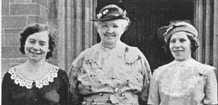
Apostleship of Prayer
Left to Right: Miss Genevieve Mahon, Secretary-Treasurer, Mrs. Ed Nixon, President; Miss Cecilia Badendieck, Assistant Secretary.
Genevieve Mahon, Secretary and Treasurer and Miss Cecelia Badendieck, Assistant Secretary. Besides distributing the regular leaflet each month, the promoters of the League sponsor a Public Hour of Adoration on the Eve of each First Friday, and hold an official meeting on the afternoon of each third Sunday.
Holy Name Society
The Holy Name Society, the first Branch established in the City of St. Louis, possesses a Document of Institution hanging on the Church Sacristy wall dated February 16, 1904, signed by Father Andreas Fruhwirth. It fosters reverence to the Holy Name of Jesus and respect for God's law. Both men and boys belong, the Junior Division receiving direction from one of the School Nuns and the Senior Division having as officers men of the Parish; Mr. Wm. Meehan, President; Mr. T. C. Kaemmerlen, Vice-President; Mr. James Brady, Secretary; Mr. James Brady, Secretary;

HOLY NAME OFFICERS
Front Row: Walter Lambert, Delegate; James Brady, Secretary; Wm F. Meehan, President; A. Beinecke, Treasurer.
Back Row: Jos. H. Bonskowski, Sergeant-at-Arms and Delegate; Louis Schmid, Delegate; T. C. Kaemmerien, Vice-President.
PAGE 57
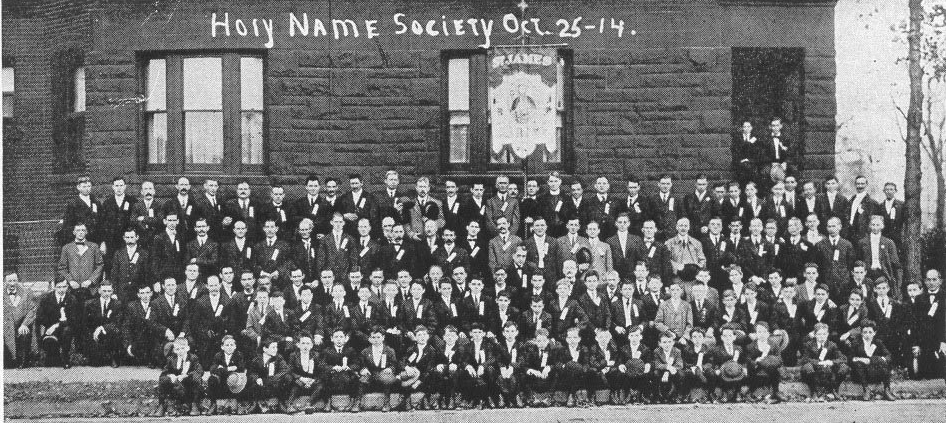
August Beinecke, Treasurer; Mr. Stephen Boyer, Sergeant-at-Arms-, Mr. Joseph Bonskowski, Sergeant-at-Arms and Delegate, Mr. Walter Lambert and Mr. Louis Schmid, Delegates.
The Society approaches Holy Communion in a body on the second Sunday of the month, and the Seniors hold their meeting on the following Monday evening.
Officers of the Junior Holy Name are: William Flanagan, President; John Weaver, Vice-President; Robert Marshall, Secretary., Lawrence Schieber, Treasurer; and John Murphy, Medal Bearer.
Queen of the Rosary Sodality
For the ladies of the Parish there is the Sodality under the title of the Blessed Virgin Mary, Queen of the Holy Rosary, and the Patronage of St. Agnes. The Document of Institution, also in the Sacristy, bears the date of April 14, 1917, and the signature of Father Ledochowski of the Society of Jesus. Every effort is made to fully comply with the Pope's idea of a Sodality, both as to purpose or aim and as to activities serving as means to an end. At present Miss Rochelle Lossos is Prefect; Mrs, P.H. Murphy and Mrs. William Menner, Vice-Prefects;

Miss Eleanor Egli, Secretary; Miss Anna Kurz, Assistant Secretary and Miss Cecilia Badendieck, Treasurer.
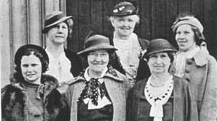
Queen of the Rosary
Back Row: Miss Anna Kurz, Assistant Secretary; Mrs Ed. Nixon, Medal Bearer; Miss Cecilia Badendieck, Treasurer.
Front Row: Miss Eleanor Egli, Secretary; Mrs. Wm. Menner, Vice-President; Mrs. P.H. Murphy, Vice-President.
Angelic Warfare Society and Guardian Angel Sodality
Connected with the Parochial School, the Dominican Sisters promoted the Angelic Warfare Society under the patronage of St. Thomas Aquinas for the older children and the Guardian Angel Sodality for the younger ones. These two societies enroll only the girls and invite into membership also those attending the Public Schools.
In the Angelic Warfare Society, Catherine Lafser is President; Marjorie Houlihan, Secretary and Treasurer and Margaret Morrissey, Medal Bearer. In the Guardian Angel sodality, Doris Gates is President; Marie Louise Ruggeri, Treasurer, Margaret Dailey and Monica Schweitzer, Medal Bearers.
PAGE 58
ORGANIZATION IN ST. JAMES PAPISH
To further every aim of the Church and to promote religious fervor, the parish has been divided into districts and the various societies and modalities I have each a promoter in the district group. The activities of all the groups are coordinated under one organization, named CATHOLIC ACTION. The Officers of this body are elected by the presidents and prefects of all the Societies. The District group are under the two consultors, one of whom is appointed by the Holy Name Society and the other by the Queen of the Rosary Sodality. The branch of the Holy Name Society is for all the men and boys in the parish. The Queen of the Rosary Sodality is for mothers and daughters who have graduated from primary school. Each of these two societies have district field workers -- a man and a woman to every block. They are the liaison officers who carry out the general orders issued by the officers of CATHOLIC ACTION, and promote the interest of their own organization.
DISTRICT NO. 1
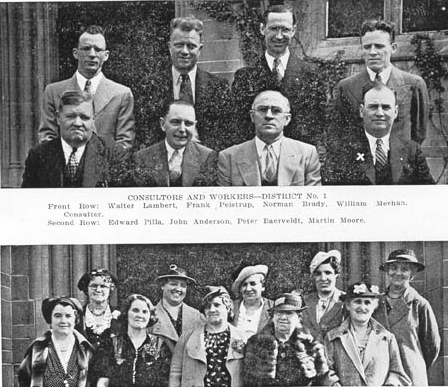
CONSULTORS AND WORKERS -- DISTRICT No. 1.
Back row: Mrs. William Kirby, Mrs. Norman Brady, Miss Mary Mahon, Miss Helen Mahon, Mrs. Henry Hugeback.
Front Row, Mrs. Henry Seager, Consultor, Mrs. William Hefele, Mrs. Ben. Plengmeier, Mrs. Margaret Moore, Mrs. Thomas Mahon.
PAGE 59
DISTRICT NO. 2
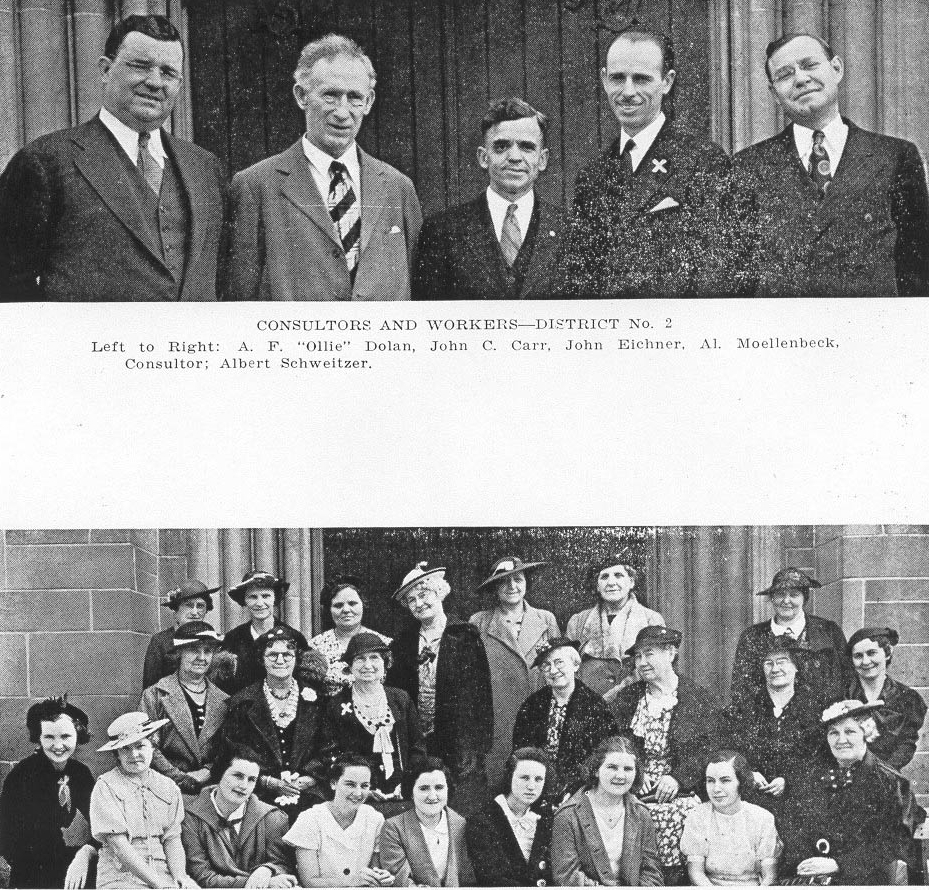
CONSULTORS AND WORKERS -- DISTRICT No. 2.
Back Row: Mrs. R.C. Mellor, Mrs. John Ulrich, Mrs. John Eichner, Mrs. J. Carr, Mrs. A.F. (Ollie) Dolan, Mrs. James C. Blythe, Mrs. Thomas Meehan.
Second Row: Mrs. Henry Hugebach, Mrs. Wm. Kirby, Mrs. P.H. Murphy, Consultor; Mrs. Dr. R.B. Murphy, Mrs. Catherine Engelhardt, Mrs. Geo. Wiber, Mrs. Albert Moellenbeck.
Front Row: Miss Mary Claire Duggan, Miss Mae Collins, Miss Eileen Duggan, Miss Mary Ellen Griffin, Miss Carmelita Kelly, Miss Rosemay Hasty, Miss Bernadine Hugeback, Miss Glorian Duggan, Mrs. Mat. McLaughlin, The ladies from West Park Avenue do not belong to this district.
PAGE 60
DISTRICT NO. 3
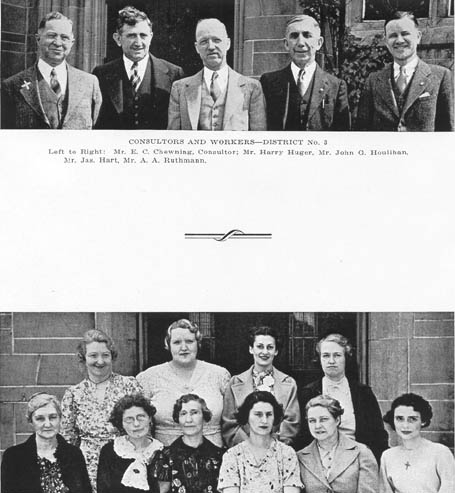
CONSULTORS AND WORKERS -- DISTRICT No. 3.
Front Row: Mrs. Mulcahy, Mrs. H. Ward, Consultor; Mrs. Huger, Theola Huger, Maria Johnson, Gladys Huger.
Second Row: Mrs. Droege, Margaret McDonnell, Ahrea Huger, Mrs. Reidelberger.
PAGE 61
DISTRICT NO. 4
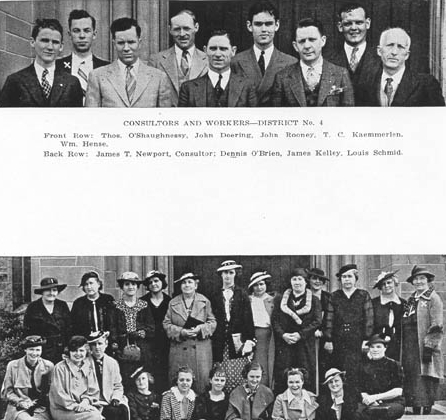
CONSULTORS AND WORKERS -- DISTRICT No. 4.
Standing: Mrs. Thomas Mayor, Mrs. W. Dulany Reese, Mrs. M. Scherzinger, Mrs. C. Schmitz, Mrs. J. Mahoney, Mrs. T.C. Kaemmerlen, Mrs. E. Dyer, Mrs. Pat Regan, Mrs. James Brady, Mrs. Louis Meier, Mrs. R.E. Pierce, Mrs. Wm. Menner, Consultor.
Seated: Mrs. T. O'Toole, Miss Anna Mayor, Miss Marie O'Gorman, Mrs. Stephen Burch, Miss Agnes Riegel, Miss Jane Scherzinger, Miss Mary Catherine Kelley, Miss Mary Jane Hruby, Miss Ruth Pierce, Mrs. John Rooney.
PAGE 62
DISTRICT NO. 5
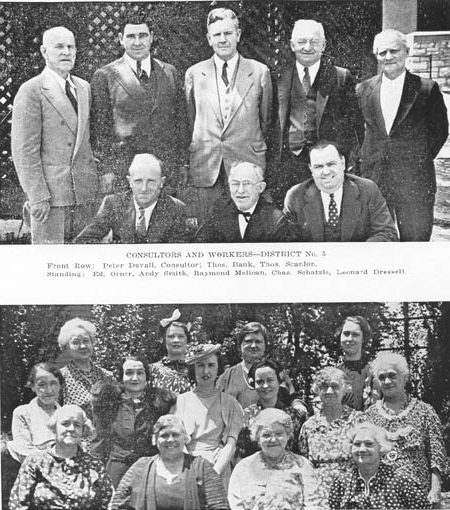
CONSULTORS AND WORKERS -- DISTRICT No. 5.
Front Row: Mrs. L. Dressell, Mrs. J. Foley, Consultor; Mrs. Thos. Banks, Agnes Kern.
Second Row: Mrs. A. Jirauch, Margaret Fahey, Ethel Irvin, Helen C. Jackson, Emma Kern, Josie Kern.
Third Row: Louise Kern, Mrs. A. Smith, Eleanor Foy, Margaret Irvin.
PAGE 63
DISTRICT NO. 6
DISTRICT NO. 7
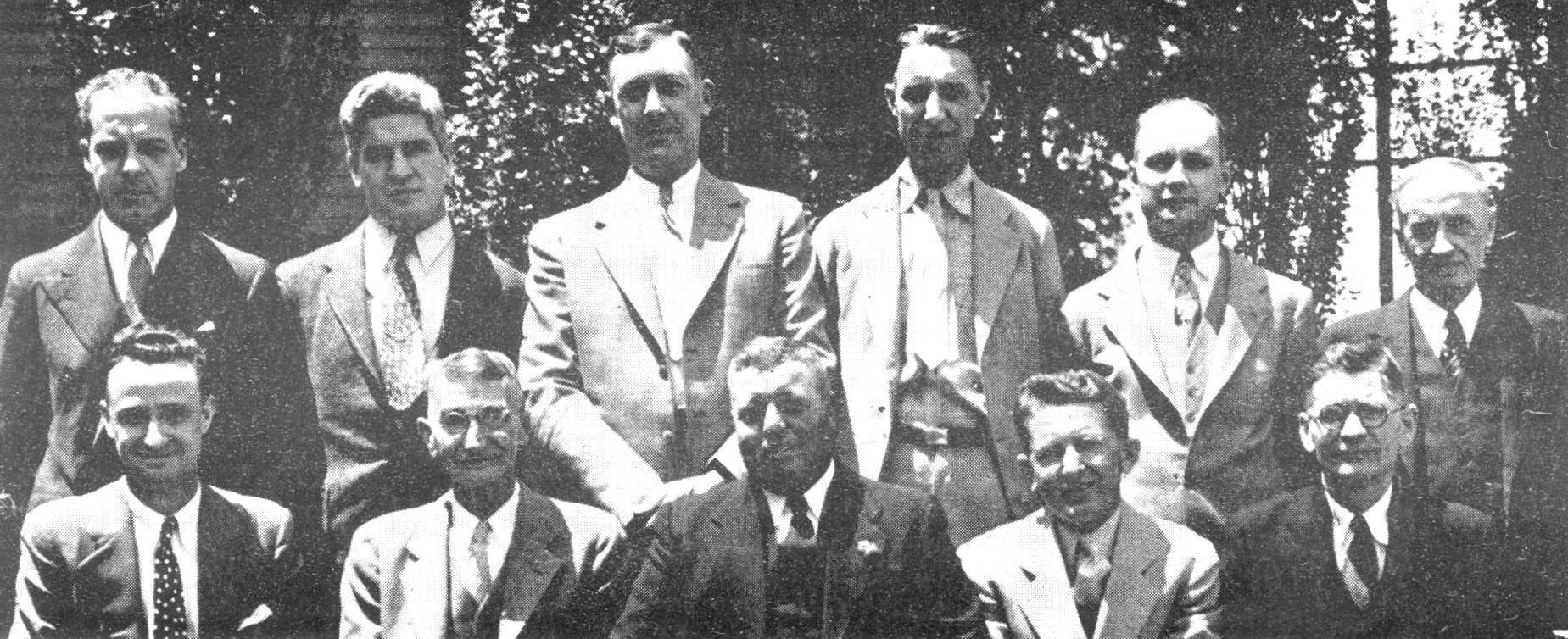
CONSULTORS AND WORKERS -- DISTRICT Nos. 6 and 7.
Front Row; Leander Mundwiller, Robert Barr, Nick Barrelli, A.L. Polster, Consultor; Stephen Boyer.
Second Row: George Boerckel, John Oates, George Frey, Robert Duffner, Fred Coad, John Long.
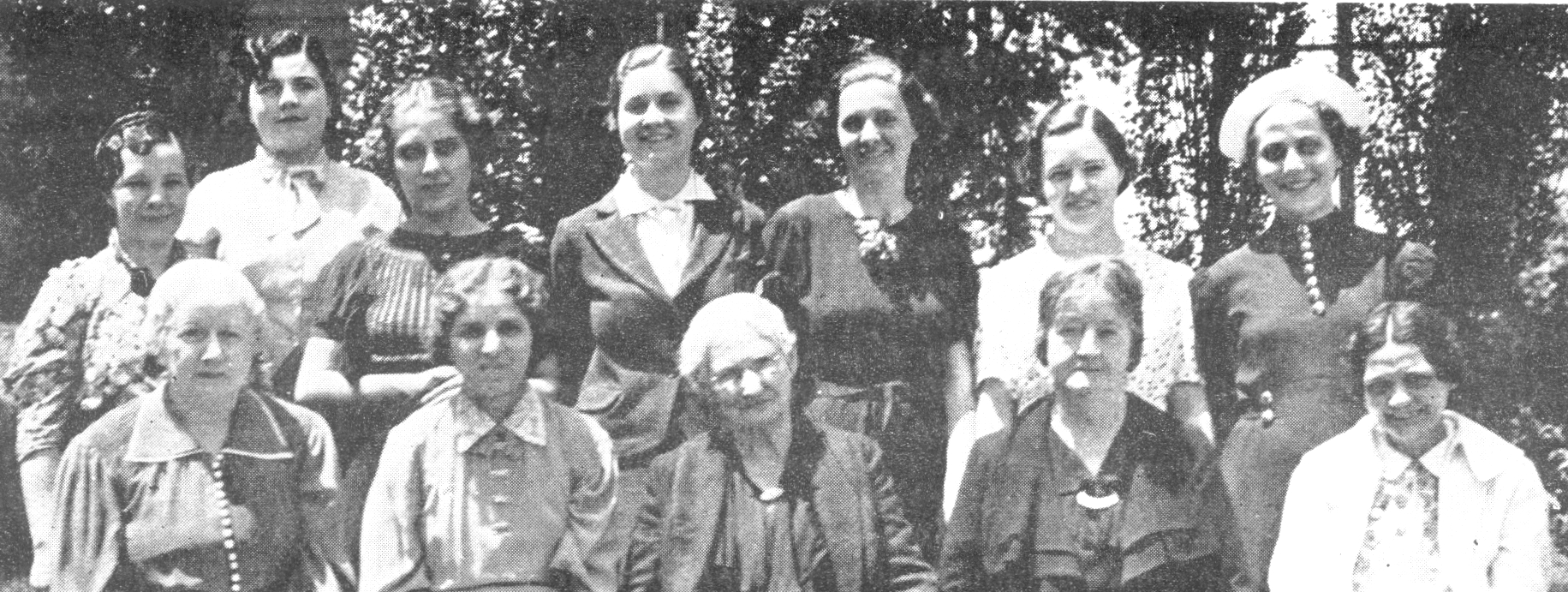
CONSULTORS AND WORKERS -- DISTRICT Nos. 6 and 7.
Front Row: Mrs. C. Heil, Mrs. F. Deschner, Consultor; Mrs E. Bisso, Mrs. J. Long.
Second Row: Mrs. M. Mundwiller, Bella Barrelli, Caroline Deschner, Geraldine Farrar, Dorothy Farrar, Beatrice Brant, Dorothy Deschner.
PAGE 64
DISTRICT NO. 8
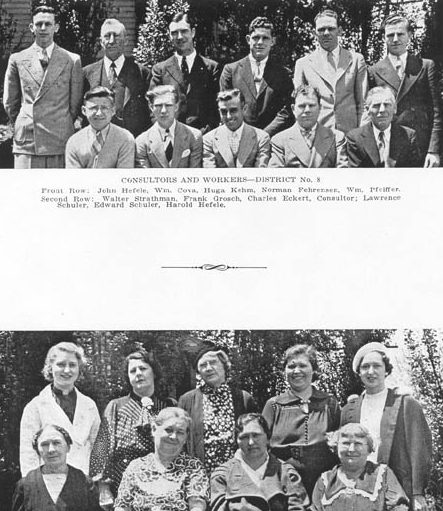
CONSULTORS AND WORKERS -- DISTRICT No. 8.
Front Row: Mrs Wm. Pfeiffer, Mrs. A. Wynn, Consultor; Mrs. Theresa Cova, Mrs. L. Combrevis.
Second Row: Mrs. Wm Pfeiffer, Jr., Mrs. F. Lenci, mrs. E. Schuler, Mrs. Chas. Eckert, mrs. Dora Frattini.
PAGE 65
DISTRICT NO. 9

CONSULTORS AND WORKERS -- DISTRICT No. 9
Left to Right: Robert Schute, A. Beinecke, Consultor, M. Kaiser
CATHOLIC ACTION!
The six principal societies of St. James cooperate in Parish activities, their respective presidents forming the Executive Committee of the Parish Catholic Action, with Mr. Morgan P. Foley as Chairman; Mr. Wm. F. Meehan, Vice-Chairman; Miss Margaret Irvin, Secretary and Mr. Frank Peistrup, Auditor. Assisting the Executive Committee are the following district consultors, each serving a separate section of the Parish; from the Holy Name Society, Mr. Albert Polster, Mr. Peter Duvall, Mr. James Newport, Mr. A. J. Moellenbeck, Mr. Wm. Meehan, Mr. E. C. Chewning, Mr. Charles Eckert, Mr. Robert Schuh and Mr. George Bayers; and from the Queen of the Rosary Sodality, Mrs. Elizabeth Deschner, Mrs. J. Foley, Mrs. Wm. Menner, Mrs. H. Ward, Mrs. P. H. Murphy.
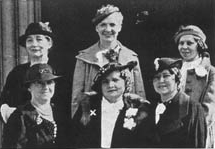
CONSULTORS AND WORKERS -- DISTRICT No. 9
Top row: Mrs. Martin Scully, Miss Bernice Schwable, Miss Cecilia Badendieck.
Front row: Mrs. Clara Jackson, Mrs. Gus Beinecke, Consultor; Mrs. M. Kaiser.
Mrs. H. Seager, Mrs. Andrew Wynn, Mrs. August Beinecke, Mrs. George Bayers.
There are many in the congregation whose picture does not appear in this book. We had not room for everyone. The implication might be they are not prominent parishioners. This would be far from true. There are many of the best people in the parish whose other pressing duties do not permit them to join in parish activities and in other instances there are parishioners who are among the most generous and virtuous, who are of a retiring disposition and never want to be seen in a front row.
These also we wish to thank for their silent and constant co-operation and their many acts of kindness to their Pastor.

CATHOLIC ACTION
Left to Right: Frank Peistrup, Treasurer; Margaret Irvin, Secretary; Morgan Foley, Chairman; William Meehan, Vice-Chairman.
PAGE 66
WHAT IS THIS CATHOLIC ACTION?

HIGHER EDUCATION: Mr. Joseph Crotty
CATHOLIC ACTION: Mr. James P. O'Gorman
SECULAR PRESS: Mr. John J. Newport
Question: What is this thing called Catholic Action?
Answer: A concerted movement made by Catholics under their Bishops to bring Christian principles into the every-day current of life.
Question: Why should Catholic principles be promoted?
Answer: Because the Catholic Church was instituted by Christ to continue His Mission on Earth.
Question: Was the Church instituted by Christ?
Answer: Consult all the Encyclopedias there are in the library. To each denomination there is given a founder, except to the Catholic Church.
Question: Why is the name of the founder of the Catholic Church not given?
Answer: Because from the beginning it was considered to have been instituted by Christ, through His Apostles.
Question: What commission did He give His Apostles?
Answer: To them He asserted that He was the Supreme Ruler of all men and as such He commanded them to "Teach all nations to observe whatsoever I have commanded you."
Question: That implies that people cannot do as they please?
Answer: Precisely. God is the Creator, the all wise law-giver. The Inventor has a right to give directions as to how His machine should be operated.
Question: But that means the end of freedom?
Answer: NO! Freedom does not give anyone the right to do wrong. Every free people should have laws that are protective and just, and no law can be that if it is contrary to God's Law.
Question: Should a free people punish a violator of a good law?
Answer: If it did not, laws would be ignored and the criminal element should rule.
Question: What is the difference?
Answer: Human rights, or those rights which men consider their natural rights, would not be protected. If rulers made their own rules Of life, they would become tyrants and men should submit to slavery.
Question: Are the principle of conduct taught by the Catholic church pleasing to God?
Answer: They should be. They are the same as those taught by Christ to His Apostles and which he commanded to them to teach all men to observe.
Question: State in a general way what these principles imply?
Answer: Love -- "Love God above all things and your neighbor as yourself for the love of God."
"Love is the fulfilling of the law" or as Victor Herbert poetically express it
Ah, sweet mystery of life, at last I've found thee,
Ah, I know at last the secret of it all;
All the longing, seeking, striving, waiting, yearning;
The burning hopes, the joy and idle tears that fall,
For 'tis 1ove and love alone the world is seeking,
And 'tis love and love alone that can repay,
'Tis the answer, 'tis the end and all of living,
For 'tis love alone that rules for aye.
Historians may draw conclusions from the past, philosophers have and will evolve new philosophies; inventors shall lessen labor and multiply the power and efficiency of the machine; economists can promote prosperity; professors in schools and universities can advance human knowledge, but the teacher most necessary today to human happiness is the man who teaches love. This is the end and aim of Catholic Action.
Question: How can Catholics promote Catholic Action?
Answer: By each of them being a Christian in act as well as belief. "Christianity," says Chesterton, "has not failed, it has not been tried."
Question: Who should exemplify it?
Answer: Catholics at least who believe in it and are temples of the Holy Ghost.
Question: Does the Holy Ghost take an interest in the affairs of men?
Answer: Yes! He is the Spirit of love and truth and exercises His influence through His Church, agency of men who believe in His gospel and regard all men as brothers.
PAGE 67
Question: How can Catholics qualify for this great missionary work?
Answer: By humble prayer, visits to the Church, frequent reception of the Sacraments, daily Mass, and joining classes that make a study of Christian Doctrine.
Question: How does a Catholic disqualify himself for this work?
Answer: By conduct contrary to the teaching of the Church, such as cursing, swearing, sensual indulgence, greed, pride, envy, drunkenness, quarrels and lack of consideration for the rights and needs of fellow man.
Question: When a Catholic intends joining the forces evil what should he do?
Answer; Join a parish sodality, associate with men who are heart and soul in this movement, get better instructed in religious topics, and then go forth into the highways and byways planting the seed of faith and Christian love.
THE LUNCH ROOM
Mrs. Emma Bovard organized a lunch room for St. James Parochial School in the year 1917. She promoted it through the
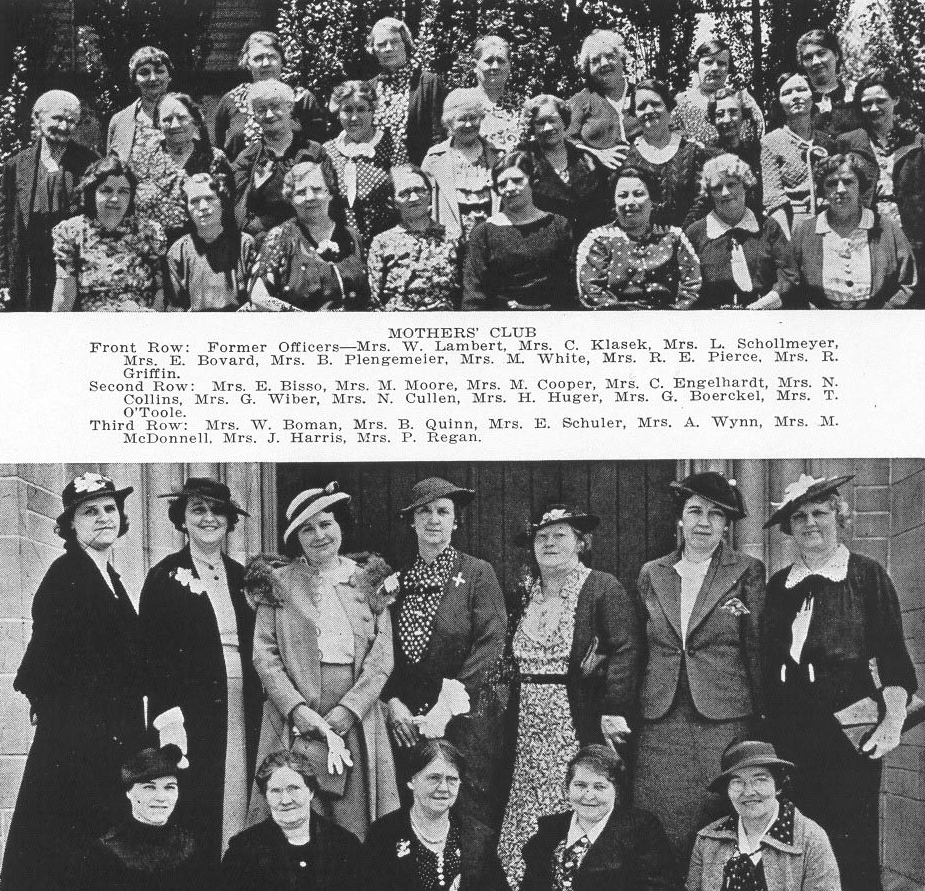
MOTHER'S CLUB
Back Row: Mrs. Clement Schmitz, Mrs. James Brady, Mrs. Eugene Dyer, Mrs. Robert Griffin, Mrs. Jerry Corbett, Mrs. Walter Lambert, Mrs. R.E. Pierce.
Bottom now: Mrs. John Rooney. Mrs. Ed Ready, Mrs. Clara Jackson, Mrs. Wm. Meehan, Mrs. Wm. Menner.
PAGE 68
Mothers' Club. that already existed in the parish.
At the time Mrs. Bovard was president, the late Mrs. Ed. Ryan was vice-president. Mrs. Ed. Houlihan was secretary and Mrs. Wiber was treasurer.
The first Chairman of the Lunch Room was Mrs. Ben Plengemeier, who served for five years. She was succeeded by Mrs. Louis A. Schollmeyer, and in succeeding years by Mrs. May White and Mrs. Isabelle Irvin, Mrs. Chas. Klasek, Mrs. Ed. Pierce, Mrs. Walter Lambert, Mrs. Robt. Griffin. Each of these directors was assisted by a self-sacrificing body of women who came on different days and cooked and served a cheap and a wholesome lunch to the children. This was a much needed service to the school, as very many children came too far to return home at mid-day.
The first five years the lunch room was conducted in the old handball court in the school. When Mrs. Chas. Klasek was Prefect of the Mothers' Club she put on a drive to raise funds to extend the lunchroom and have it suitably furnished and decorated. The cafeteria that is now being used for a variety of services cost $1000.00 and every cent of it was furnished by her and with the cooperation of her associates.
In the picture herewith are many of the earlier members who served in the cafeteria.
ATHLETICS UNDER CATHOUC ACTION
Athletics are a church interest because they are youth's interest. The boys and girls of St. James Parish have been for the past five years, under the direction of Mr. J. Anderson, 6401 Manchester Ave., and the progress of his teams has constantly advanced. The boys have won many, trophies in baseball and soccer, but the prize for which there has been most rivalry is the Jules Monti Trophy, for which there is an annual contest at Christian Brothers' High select athletes from Parochial City Schools.
St. James pupils have been second in Parochial track meets for the past four years. They were determined that the Jubilee year of the Parish should also be the year to bring home the trophy -- and they did it, on decoration day, May 31. Mr. Anderson and his boys easily obtained the victory. The athletes from the Parish who were successful are:
John Murphy, won 50 yard dash and broad jump; William Flanagan, 75 yard dash and second on the 220 yard dash and 100 yard dashes; William Cumberland 880 yard runs and second in broad jump; James Walsh, second in 880 yard run; Anthony Mirrelli, second in 440 yard dash.
ATHLETICS IN CHELTENHAM
Athletics in Cheltenham reached its high peak on a commercial basis when Geo. Gittins organized his baseball team and built
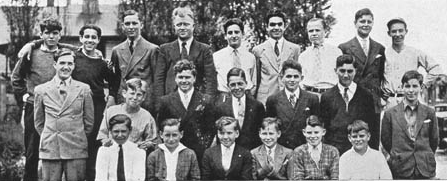
PAROCHIAL TEAM
Front Row: John Murphy, James Walsh. Joseph Eichner, Robert Baerveldt, Thomas Marshall, Charles Schmid.
Second Row: Frank McLaughlin, Joseph McMahon, Anthony Mirrelli, Lawrence Schieber, Owen Thompson, John Garavaglia, Thomas Brady.
Third Row, John Eichner, Edward Buckley, Robert Anderson, John Anderson, Sr., Louis Santambrogio, John Palumbo, William Cumberland, John Vorbeck, William Flanagan.
PAGE 69
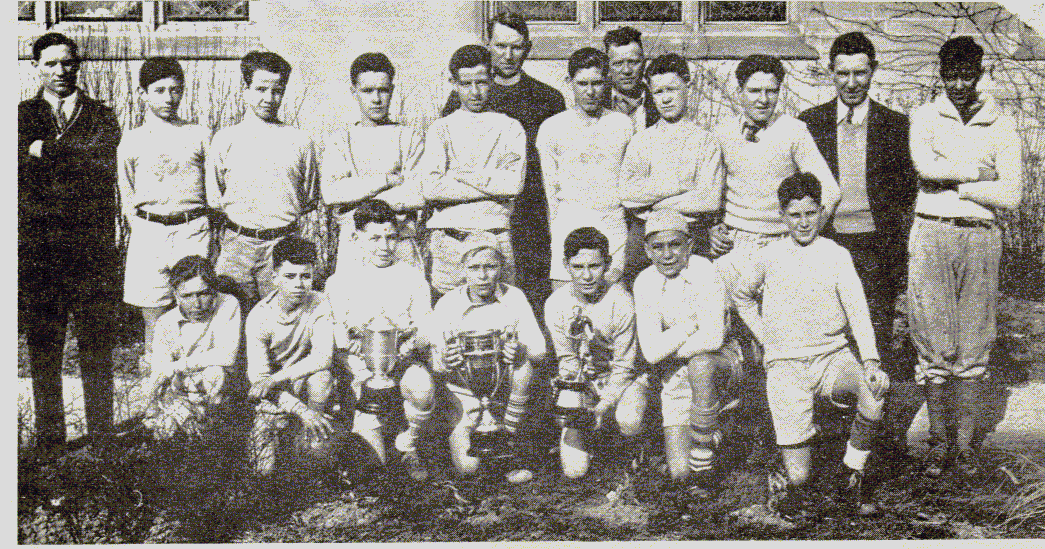
ST. JAMES PAROCHIAL LEAGUE -- 1933 Soccer Champions:
Kneeling: Edward Hart, Edward Buckley, Charles Klasek II, Robert Anderson, Edward Sugden, John Anderson, Jr., David Mudd.
Standing: Mr. John Rooney, Timothy Barry, George Scherzinger, William Wack, William Griffin, Dan Murphy, Robert Wack, Lester Gagan, Mr. Dan Murphy, Sr., Michael Eichner.
Rear: Rev. P.J. O'Connor, Pastor, Mr. John Anderson, Sr., Manager.
a park on a field on Cheltenham Avenue (now West Park) in the nineties. He imported players and had two big games each Sunday with the pick of St. Louis teams. His team often played the famous "Orphan Boys." He later moved his park to Tamm and Clayton. "Minnie" Hardin, for many years a big league pitcher, had his start with this team. Another team of the neighborhood at that time was the Millers.
Frank Clegg, the uncle of Arnold Clegg, was a pitcher that introduced the curve ball to the Cheltenham team and defeated them shamefully fifty years ago.
Later, soccer became the popular game of the neighborhood and many teams and individual stars were developed. The pioneers in this capacity were the Houlihan Brothers, John G., Edward and Ralph. Soccer's greatest boosters were: Wm. Hense, Sr., and his son, Wm. H. They promoted and sponsored some of the best non-professional teams in the city leagues; won several league championships and engaged in finals for the city championship on a number of occasions.
The soccer team sponsored by Scullin Steel Co. was champion of the professional league and reigned for a number of years as the champion team of the Central States and on one occasion won the National Championship. On this team were Dan Murphy, Jimmie Nolan, and John Rooney.
Other sponsors of leading soccer teams were Ray Dolan, John Anderson and Hap Pfeiffer.
Verdino (K G. "Jock" Bellairs) of the Star Times lives at 1035 Childress Avenue and is a cherished friend of Father O'Connor's.
THE HISTORY OF THE BOY SCOUT TROOP NO. 16
ST. JAMES CATHOLIC SCHOOL
The first charter was granted to Troop No. 16 in the year 1930. Mr. Morgan Foley became the first Scoutmaster of the Troop, with an enrollment of 32 Scouts.
Under his direction the Troop carried on successfully until his health became impaired and he was forced to relinquish leadership of the Troop.
During, the period from 1933 to 1937. James Pierce handled the Troop as Assistant Scout Master.
February of 1937, an organization meeting was held for the purpose of reviving Troop 16.
Resulting from this and other meetings, a Troop Committee was appointed. consisting of: Mr. Frank A. Walsh, Chairman, Mr. Peter Baerveldt and Mr. J.J. Cummins.
On the recommendation of the Pastor, Rev. P.J. O'Connor, and the Troop Committee, Noble H. Davis, Jr.. who was formerly Assistant Scoutmaster of Troop No. 98. St. Roch's Church, and who has been active in Scout Work for the past 10 years, was appointed Scoutmaster.
PAGE 70
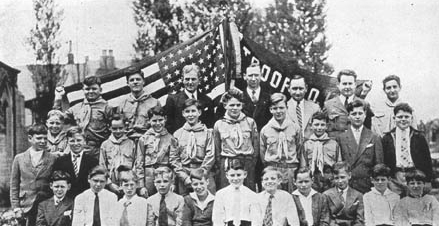
BOY SCOUTS TROOP 16
Front Row: Patrick O'Donnell, John Murphy, John Burch, Robert Reese, Robert Droege, Robert Marshall, Thomas Menner, James Walsh, Robert Baerveldt, Lawrence Gallaher, John Scherzinger.
Second Row: William Diefenbach, Robert Houlihan, Philip Schwable, Dolan Walish, James O'Shaughnessy, Thomas Brady, Owen Thompson, Thuri Zundel, Arnold Schmitt, John Vorbeck, John Cummins.
Third Row: Robert Dolan, Charles Billings, Mr. J.J. Cummings, Sr., Committeeman; Mr. Peter Baerveldt, Committeeman; Mr. Frank Walsh, Committeeman; Noble Davis, Scoutmaster; Louis Santambrogio.
Troop No. 16 was chartered March 30, 1937, with an enrollment of 28 Scouts. Regular meetings have been held weekly every since.
Among the activities of the Troop have been hikes and Mothers' Day Communion Breakfast. In addition many of the Scouts have passed their Tenderfoot and Second Class tests.
The Troop is divided into four patrols as follows: Black Bear, Flying Eagle, Panther and Lion.
Future activities of the Troop will include participation in the Fall Merit Badge Show held by the St. Louis Council of Boy Scout. Tentative plans are also under consideration for the holding of a Troop Summer Camp in 1937.
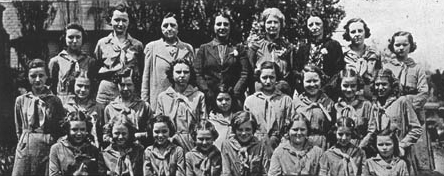
GIRL SCOUTS TROOP 105.
Front Row: Mary Catherine Lane, Mary Alice Morkoetter, Patricia Brady, Mary Jane Murphy, Agnes Dolan, Virginia Vorbeck, Catherine Moellerbeck, Clara Kearney.
Second Row: Margaret O'Donnell, Helen Roach, Mary Ellen McVey, Mary Jane Moulden, Dorothy Eichner, Elizabeth Walsh, Catherine Kearney, Theresa Roach, Emma Harnes.
Third Row: Rosemary Hasty, Frances Walsh, Mrs. A.F. Dolan, Committee Member; Mrs. Bess Gallaher, Captain; Mrs. C.P. Billings, Committee Member; Mrs. Frank Walsh, Committee Member; Anna Dempsey, Marjorie Houlihan.
PAGE 71
LET'S GO
As a means of inspiring enthusiasm for a new Church, Father O'Connor decided to begin publishing a monthly parish paper. The first issue appeared on March 21, 1925 and consisted of four pages. This issue carried an announcement of a donation of the site for a new Church by Mr. and Mrs. M. J. Macken.
At the top of the front page appeared the following declaration of intentions: "This pamphlet was conceived in enthusiasm by men and women who are bristling with PEP to build a Beautiful Church in St. James Parish. They are impatiently waiting; they are clamoring for action. They want YOU to know what they propose doing. They hope you will be with them. Don't look for a seat in the Grand Stand -- People who do things move, the disinterested sit and watch. -- Our Parish Big Drum is beating, a marching tune "Let's Go."
The name of the periodical and the slogan of St. James Parish then became "LET'S GO." The staff announced for the paper was: Rev. P. J. O'Connor, Director; Wm. T. Boman and. Robt. E. Pierce, Editors, Daniel J. Coad and P. H. Murphy, Advertising. Father O'Connor's crisp style of writing made the periodical interesting, and read from cover to cover by all parishioners. He soon had a long list of requests for copies to be mailed to all parts of the U. S. and to the homeland of immigrants. In his free flowing style he was able to convey the message he had to deliver and still hold the interest of the reader. Some of his articles had a general interest and were published in other papers. His article "Prosperity around the Corner but has a broken axle that needs Government re- pairs" was written before Franklin D. Roosevelt was thought of as a candidate for the presidency.
Through the untiring efforts of the Advertising staff and the generosity of the local merchants sufficient advertising was sold to make the paper entirely self-supporting. LETS GO had a continuous monthly publication from March 1925 until July 1932 when it was discontinued. The main objective having been reached, there was no further need for taxing the energy of the Pastor or of continuing the burden on the advertisers. The publication was discontinued with the July 1932 issue.
A feature of LET'S GO was Uncle Henry's Letter. It covered personal items which had to be told "with a smile" and woven into the fabric of a letter. "Uncle Henry," typical of all keyhole peeking columnists was often in hot water, and on several occasions narrowly avoided disaster. He went blissfully on his way, however, arguing that the percentage was all in favor of saying things which made one person mad, while giving a thousand others a laugh.
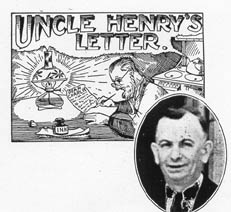
Mrs. William Boman was the stenographer for LET'S GO. She donated her services and for many years missing many a mean on days before LET'S GO went to press.
Ed. Pierce (Uncle Henry).
Mr. and Mm. Macken's Gift
On Saturday evening, March 14, 1925, Michael J. Macken and his wife, at their home, l354 Semple Avenue, signed their names to a deed in the presence of Father O'Connor, James P. O'Gorman and Ray Dolan, which transferred a city block of property on Tamm Avenue between Nashville and Wade Avenues, to St. James Parish an a free gift for the site of the new Church. The estimated value of this property was between nine and ten thousand dollars. It fronted 200 feet on Tamm Avenue and had a depth of 160 feet on Wade and Nashville Avenues.
A strip of 35 feet on Tamm and Wade Avenues was sold by Mr. Macken in August, 1924, to Mr. and Mrs. William T. Boman, 6425 Nashville Avenue, and plans were made to erect a bungalow, but on being informed by Father O'Connor that the church hoped some day to purchase the rest of the lot from Mr. Macken and would need this portion also, Mr. Boman suspended his decision and let the lot lie idle.
PAGE 72
When it was represented to Mr. and Mrs. Macken that they ought to donate the entire site for the church, they agreed to arrange with Mr. Boman for the repurchase of this lot and an exchange of property was made that was agreeable to both parties. Mr. and Mrs. Boman were as anxious to help the church as were Mr. and Mrs. Macken. A fine spirit of generosity and charity was manifested.

Mr. Macken was born in Ballen Robs, County Mayo, Ireland, and served as a draper's assistant in his native village until he married Miss Donnelly, a Roscommon girl. Fifty years ago, at that time, the couple set out for St. Louis. "God," he said, "has been very good to me. I have prospered and we are getting old. It is the greatest pleasure of my life to give this piece of property to be the site of a Catholic Church." There was a tear of gladness in his eye as he said those words and to conceal his emotion, he had his little joke: When Father O'Connor gave him the dollar required in the form of contract, "I have," he said. "given many a dollar to priests, but this is the first that ever I received from one of them."
Mr. Macken's gift was a splendid spiritual urge to the people of St. James Parish to get busy about their proposed New Church, at well as a substantial aid.
Copied from Let's Go, Issue October, 1927
When the cornerstone of St. James Church was laid on Sunday, September 18, 1927 there was a reunion such as was never witnessed before in the history of the parish. Old men who were present when the cornerstone was laid for the first church in '61, with tear-dimmed eyes watched the Archbishop place the stone for the magnificent new edifice, and later in the exchange of recollections, reviewed the years that have gone by, and were apparently happy that they had lived to see the success for which so many hoped. There were old ladies, too, now grandmothers, who had vivid recollections of the morning when they were brides in the modest building that was long since destroyed by fire; they told their children and grandchildren of the struggle, and the stress, of the fires, and the storms, of the merrymakings and the funerals, that were to them a vivid part of the past and which now was covered with the dust and ashes of bygone days. It was pathetic to hear them talk and see them move with a half-animated effort to revive their youthful ambitions, and a ray of gladness and of satisfaction crept over their withered faces as they pointed to the site and marked the location of parochial edifices.
There were others whose memories did not go so far back; they shared in the parish life when Father Casey was Rector and they told many a humorous tale about him.
At 3:45 p.m. a parade began to form at the southwest entrance of Forest Park and in the quarter of an hour that elapsed before Mr. Frank Walsh gave the signal to start there was much hand-shaking and many affectionate greetings. It appeared that everyone who ever lived in the parish even for a short time, had returned and met someone who knew him and greeted him with gladness.
Before the parade had proceeded far, it was joined by the Archbishop who "pick up" Father O'Connor and led the way to the Church
As the procession approached the parochial school it was reviewed by a large gathering of diocesan clergy and a vast concourse of people. First appeared Capt. Hanna and Lieut. Hussey and their adjutants of the Mounted District, followed, by the Knights Of Columbus Zouaves, immediately preceding the boys from the parochial school marshaled by Dan Murphy and Dan Sheehan; each boy carried an American flag and marched with military bearing and religious fervor. The little girls came next, the young ladies marshaled by Martin Coad, and the men of the parish preceded by Michael Maloney bearing the flag of St. James. The Daughters of Isabelle, led by Mr. Ryan, enlivened the match, and the Catholic Scouts, the Knights of Columbus, and Holy Name Societies of the neighboring parishes, the Catholic Church Board of Maplewood, Charity Band of Maplewood and St. Edward's Drum Corps, increased the impressiveness.
PAGE 73
Father Prendergast, Master of Ceremonies, in absence of Father Spencer, who was ill, formed the altar boys in line. Anthony Palumbo, the only parish student, carried the Cross. A way was opened through the crowd and the clergy, about thirty in number,
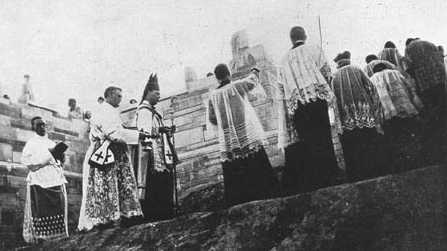
LAYING OF ST. JAMES CORNERSTONE
Archbishop John J. Glennon, D.D., officiating; Rev. John Lyons, Deacon; Rev. Timothy O'Sullivan, Subdeacon.
followed by the Archbishop, robed in Mitre and Episcopal regalia, proceeded to the Cross erected at the place marked for the main altar, then the cornerstone was blessed, a trowel was handed to the Archbishop who smoothed the mortar where the cornerstone was to rest, the stone setters set the stone in place, the chanters sang the litany of the Saints, the clergy responding, and the procession moved around the church whilst the Archbishop sprinkled the outer wall of the foundations with Holy Water. This completed the ceremony and the Archbishop, accompanied by Father Lyons and Father O'Sullivan, went to the speakers' stand which was erected at the front of the building, facing Tamm Avenue, where a vast concourse had already congregated.
In the speakers' stand were also Father Souvay, President of Kenrick seminary, Father Ryan, ex-President, Father Lavery, who made the chief address and Father O'Connor. As might be expected, Father Lavery gave a very eloquent address explanatory of the ritual pertaining to the cornerstone laying, and paid a generous tribute to the sacrifice and generosity of the people of the parish and to Father O'Connor about whose title he seemed to be a little uncertain. "I don't know," he said, "whether he is pastor or administrator but whatever he it, he has done splendid work."
Father O'Connor, on being motioned by the Archbishop to speak, addressed himself to the former parishioners, to whom he extended a welcome, and an invitation to continue to be in the parish. "There are," he said, "thirty acres adjoining the rectory recently subdivided, where streets and sidewalks and sewers are built, and splendid locations for homes can be purchased at moderate prices. These I would have you occupy." He referred to the two big donations made to the parish by Mr. Macken and Mr. John A. Quinn as being tributes of faith and generosity made by men outside the parish who vied with one another in having the honor of erecting an altar in a parish church. It was given, he said, to Mr. Macken because he had already donated the site and Mr. Quinn, whose wife became a convert in St. James was satisfied to have the distinction of erecting the beautiful Stations of the Cross which adorn the new church. He jocularly said that he was fortunate in having
PAGE 74
reached those before the Archbishop had begun his drive for the Seminary for undoubtedly these donations would have passed into that fund. He added a few complimentary remarks about the Archbishop's helpfulness, referring to his judicious suggestions and gentle manner. He finally asked the people to show their appreciation of His Grace by wholeheartedly co-operating with him in creating a fund for the New Seminary.
The Archbishop was brief in his remarks and spoke mostly about the seminary in its relationship to the parish church. He congratulated the pastors and parishioners on their good work and completed the ceremony by giving his blessing.
The following priests were present., Rev. John Nugent, St. Catherine's Church; Rev. Mark Carroll, Rev. John Kane, Sacred Heart. Rev. John Long, St. Agnes; Rev. P. J. O'Rourke, and Rev. Robert McKeon, St. Mark'a; Rev. C. Maxwell, St John's. Rev. John O'Neil, St. Edward's; Rev. Jos. Newman, St Teresa's; Rev. J. J. McGlynn, St. Rose; Rev. John Peters, St. John Baptist; Rev. Tim Meaher, St. Pius;. Rev. Jos. McMahon, St. Luke's; Rev. John Ryan, Maplewood.
The Document in the Cornerstone
"By the grace of God Almighty in the year one thousand nine hundred and twenty seven of Our Lord and Saviour Jesus Christ, in the month of September, on the eighteenth day, at the hour of four in the afternoon, in the fifth year of the glorious reign of Achille Ratti, Pius the Eleventh, Vicar of Christ and Successor of Saint Peter, Supreme Pontiff of the universal church, represented in these United States of America by His Excellency, the Most Reverend Pietro Fumasoni-Biondi, the twenty-third year as Archbishop of Saint Louis of the Most Reverend John Joseph Glennon, the ninth year as administrator of this St. James Parish of the Rev. Patrick J. O'Connor, assisted by the Rev. Norbert E Pohl, in the presence of numerous clergy and an immense gathering of the Catholic lay organizations of the City of St. Louis, the cornerstone of this elegant edifice dedicated to the glory and worship of the Triune God and under the special patronage of the Apostle Saint James the Greater, was blessed and sealed by the hand of the Most Rev. John J. Glennon, Archbishop of St. Louis, assisted by Rev. John Lyons, and Rev. Timothy O'Sullivan as deacon and sub-deacon, Rev. Ed. Prendergast and Rev. John Nugent, master of ceremonies and Rev. John Kane and Rev. Mark Carroll as chanters. In the memorable
"In the memorable year of the great devastating flood of waters in the lower Mississippi Valley, when Col. Charles A. Lindbergh flew alone in a monoplane from the American Continent to Paris, France; and many European aviators lost their, lives in fruitless endeavors to cross from Europe to America, in the third year of the Honorable Calvin Coolidge (second term) President of these United States, in the third year of the Honorable William Baker, Governor of Missouri, in the third year of the Honorable Victor Miller, Mayor of the City of St. Louis and on the spot designated as 1351 Tamm Ave. at the south side of Forest Park and in the City of St. Louis, the above mentioned cornerstone was deposited.
"At this time St. James Parish has been established sixty-five years, and has a parochial school directed by seven Dominican Nuns in which there are three hundred and thirty pupils. There are approximately seventeen hundred souls in the congregation and the majority of them are instructed in the rudiments of the faith and appreciate the grandeur and dignity of being Christians.
"May this worthy ecclesiastical structure which was designed by O'Meara and Hills. architects, and made possible through the generosity of many who were comparatively poor, serve to gather and to keep the faithful of this and future generations in peaceful union and loyal worship of God here in the church militant and assist them to the blissful union and celestial joys of the Church Triumphant Heaven."
(Let's Go)
THE OPENING OF THE NEW CHURCH
St. James Church was informally opened for service on Saturday, August 11, 1928, at 4:30 P.M., when confessions were heard by Rev. P. J. O'Connor. Adm., Rev. Norbert E. Pohl, Asst. Pastor, and Father Joseph J. Wahlen, Order of the Mission of the Holy Family. A large number of penitents presented themselves and the three priests were kept busy with the exception of an hour for supper, until 10:30 P. M.
The first confession heard was that of John P. Dolan, who battled with a number of others for the unusual distinction. The church was not entirely finished, the floors were not polished, the Stations of the Crow had not arrived, pews were not installed, a temporary altar was erected and the Sanctuary lights and reflectors were not in place.
A Solemn High Mass was offered on the following morning, Sunday, at 5:30. The celebrant, Rev. P. J. O'Connor, Adm., deacon, Rev. Norbert F- Pohl, sub-deacon, Rev. G. A. FitzGibbons, S@ J. Father O'Connor
PAGE 75
in his sermon said: "In the name of the congregation, I am presenting this Temple this morning to our Lord Jesus Christ, whose home it shall be in our midst for all future time; you shall enter it with reverence and be always mindful that you are in the palace of our Divine King. You shall come with your petitions and your praises and unite with the priest in offering the divine sacrifice. Here you shall bring your children to be baptized, the last remains of your dear ones for requiem Mass; here you shall pledge your vows and solemnize your marriages.
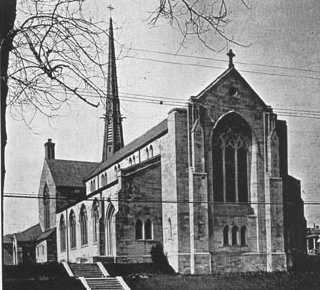
"At the back of altar there is the picture of Christ, the King, acknowledge this morning that you are His subjects, willing to give Him and His Church obedience and love, consecrate to Him your lives, your minds and give Him the submission of your wills. Assure Him from henceforth with the help of His grace you will be more faithful in practicing your Faith and keeping His commandments, and when the Sacred Host is consecrated give Him a silent welcome before uniting with the congregation in singing "O Salutaris Hostia."
Anthony Palumbo, an ecclesiastical student, was Master of Ceremonies, and the first to receive Communion. The following altar boys also assisted, Waldo and Dean Bisso and John Coad.
About 320 members of the Holy Name Society went to Communion and the majority of a capacity congregation also received.
Miss Minnie Carreras played the organ and Charles W. Heil directed the choir which comprised the following members, Mrs. Frank Walsh, Miss Bernadine Quinn, Miss Angela Kollias, Miss Helen Muehling, Miss Margaret Cenatiempo, Miss Rose Gioia, William Koncen, Joseph Pieschel, Geo. Jenneman, Bernard A. Kelly, Louis Riegel, George Wiber.
Owing to the number going to Communion, the Mass was not over until 7:15, when another Mass was offered by Father O'Connor.
Rev, FitzGibbons, S. J., was the second priest to officiate. His Mass was offered at 7:45.
Rev. Norbert E. Pohl offered the 9 o'clock Mass and sang a solemn Mass at 10 o'clock which was followed by Benediction.
At 3:30 the Sacrament of Baptism was administered and Richard James O'Gorman, 6464 Lloyd Avenue, whose great grand-father and great grand-mother, Mr. and Mrs. John O'Gorman, were charter members of the parish and are recorded in the first list of parishioners that is extant, was the first to receive baptism; Margaret Ann Harrison, 6435 Nashville Avenue, Leo Alfred Ginther, 6149 Elizabeth Avenue, the twelfth child born to Mrs. and Mrs. Ginther, were also baptized.
Chairs to take the place of pews were lent to the parish by the Immaculate Conception Churches of St. Louis and Maplewood.
(Let's Go.)
THE DEDICATION OF THE NEW CHURCH
On Sunday, October 7, 1928, at 10:00 A. M., St. James Church was dedicated by Archbishop Glennon with deacons of honor, Rev. M. S. Ryan, C. M., D. D., former president of Kenrick Seminary, and Rev. Daniel J. Lavery, D. D. About forty priests were present at the dedication or at the Mass and
PAGE 76
thirty-three remained for lunch, which was served by a catering company in one of the halls in the school. The priests, who did not tarry for lunch, went to the World Series baseball game.
Among the clergy present were Very Rev. P. P. Crane, the Vicar General of the Arch. diocese; Very Reverend Charles Souvay, C. M., D. D., president of Kenrick Seminary; Dean Eugene Coyle, pastor, Kirkwood; Rev. Joseph P. Newman, St. Theresa's (since dead); Rev. Thomas D. Lloyd, St. Edward's; Rev. Paul Ritchie, St. Lawrence; Rev. Joseph English, Epiphany; Rev. Joseph Collins, Visitation; Rev. I. Douglas, St. Ann's; Rev. Thomas Kennedy, St. Philip Neri; Rev. John H. Long, St. Agnes; Rev. Father Lane, C. M., St. Bridget's; Rev. John Godfrey, Ferguson; Rev. George Ryan, Holy Angel's; Rev. Daniel Ryan, Christ the King; Rev. William Nugent, St. Rita's; Rev, John Nugent, St. Catherine's; Rev. George Keating, Sts. Mary and Joseph's; Rev. Tim McKeough, Mitchell, Illinois; Rev. M. Costello, Granite City; Rev. Joseph Hirner, Luebbering; Rev. John D'Arcy, St. Thomas; Rev. Joseph Sullivan, Immaculate Conception; Rev. T. Weinig, Our Lady of Sorrows; Rev. Michael O'Keefe. Holy Rosary; Rev. Cornelius Kane, New Franklin.
Officers of the Mass: Rev, John J. Lyons, St. Pius, celebrant; Rev. Peter J. O'Rourke, St. Marks, deacon; Rev. John J. Butler, St. Lawrence, sub-deacon; Rev. Robert McKeon, First Master of Ceremonies; Rev. John Ryan, Maplewood, Assistant Master of Ceremonies; Rev. Arthur White, Pine Lawn, and Rev. Mark Carroll, Deacons of honor to Right Rev, E. Byrne, Rev. Joseph P. Newman and Rev. Michael O'Leary, St. Malachy's.
The Archbishop, in his short address, congratulated the pastors and congregation on their magnificent and beautiful church; he compared it to the temple of Jerusalem which, he said, was domed by cedars from Lebanon, marble and gold from the mountains, and precious stones from Arabia and Egypt. "You have in this temple the best that craftsmanship can accomplish in wood, stone, bronze, iron, plaster, and furniture. There are gems of many hues in the art glass of the various windows, gold in the decorations of the walls, a harmony of colors in the tapestries, and a charming elegance to the entire building. I would like to make this church the Cathedral of the South Side. It is magnificent and beautiful."
The clergy were apparently as favorably impressed and expressed themselves in terms of unstinted praise. Bishop Byrne's remarks were also very complimentary. He said, "In the ancient city of Zarapossa, Spain, where the Ebro flows broad and shallow toward the Mediterranean, there rises a magnificent Church, whose many turrets are mirrored in Ebro's lazy waters. This great building covers the spot where your St. James dedicated a chapel to and set up a statue of the Blessed Mother on a pillar. This chapel of our Lady of the Pillar was perhaps the first chapel in all the world dedicated under the patronage Of the Blessed Virgin.
"This parish, ought to be a place of deep and tender devotion to the Blessed Mother. Here, October and May should be truly blessed months. Every member should possess a Rosary and use it. The walls of every home should be adorned with some pictures of the Virgin. Here, the priest should not be answered after Mass by a subdued murmur, but the people of St. James should answer the Hail Mary's in full, round voice.
"Your St. James was among the first of the apostles chosen by our Blessed Lord. He was a fisherman, the son of Zebedee, a fisherman, and the brother of St. John, the Evangelist, the beloved disciple. He, with St. Peter and St. John, were the only witnesses of the raising of the dead of daughter of Jairus, and of our Lord's Transfiguration as well as of his agony and bloody sweat in Gethsemane.
"He was the first of all the apostles to die for the faith. A King Herod of the same foul breed as him who, in jealous quest of the Infant Saviour, filled Rome with lamentations, the Acts of the Apostles informs us 'killed James, the brother of John, with a sword.'
"In northwest Spain, in the land of stubbornly Catholic and sturdy Basque, there is a City of San Tiago, City of St. James. There in a magnificent cathedral church is preserved the relics of St. James. The story is, that after his murder by Herod, the body of St. James was entombed near the temple of Jerusalem. In the ninth century pious Spaniards, returning from a crusade, carried the body with them to Spain. San Tiago, under the old name Of Compostella, was the Episcopal see of St. James. A long list of illustrious bishops have succeeded him there, many of them Saints, among them the reputed author of the prayer, 'Salve Regina.'
"You have chosen well, when you called your Church St, James, but the title should not be an empty one; you have chosen him to be your parish protector, and that you may imitate his virtues.
"Let this parish be a place of vocations to the priesthood and religious life. 'And going on from thence, he saw afar two brethren, James, the son of Zebedee, and John, his brother, in a ship mending nets; and he called
PAGE 77
them and forthwith they left their nets and father and followed him.' What beautiful obedience and surrender to the grace of God. The youth of St. James have a great example set up for them in the title of their new Church.
"St. James' parishioners should be loyal Catholics, active in all that is for the glory of God, and the salvation of souls, men and women without fear, and without human respect. St. James and St. John were called the sons of Thunder. The stout assertion, 'we can' of these saintly and manly brothers should be the answer to every call from your Archbishop and your pastor. St. John says in his first epistle, 'He that knoweth God heareth us. He that is not of God, heareth us not.'
"The men of St. James should be staunch defenders of the honor of Christ and His Holy Church.
"When the hostile Samaritans offered insult instead of hospitality to our Blessed Lord, the Thunderers, John, and your St. James, suggested that He call down fire in punishment on the heads of these irreverent men. True, our Lord rebuked their imprudent zeal and over-wrought loyalty; but the fine spirit of their purpose is in marked contrast to the indifference and neglect, today, of so many Christian men, when their Church and her teaching are misrepresented and reviled. Peter's cowardice and denial are so often met, where we would expect, and ought to have the instant and vigorous protest of John and James."
Bishop Gilfillan of St. Joseph, who was unable to be present at the dedication, visited during the week and said he was expecting, because of previous information, to see a very beautiful Church, but he did not anticipate finding anything so charming. "It is, he observed, "the neatest parish church I have ever seen.
The Architects of St. James Church, O'Meara & Hills came to St. Louis in 1923. They specialize in the design of "Catholic Churches and Institutions."
The following projects in St. Louis have been designed by this firm: St. George Church; St. Wenceslaus Church, School and Convent; De Paul Hospital; St. Mary's Motherhouse and School for Nursing; Villa Duchesne; St. Michael's School; St. Rita School; St. Anthony's School; The "White House" Retreat; Holy Rosary Rectory; Carmelite Convent; St. Louis University Gymnasium; St. Ann's School, Normandy; Passionist Fathers Seminary; Monastery Redemptorist Fathers.
THE STAINED GLASS FOR ST. JAMES CHURCH
Was executed and designed by one of America's foremost Artists, Mr. Thomas Gaytee of Minneapolis.
Mr. Gaytee furnished the glass for the Pro-Cathedral in Minneapolis, Mary's Motherhouse Chapel, DePaul Hospital Chapel and St. George's and St. Wenceslaus Churches in St. Louis.
Mr. Gaytee died in December, 1936.
MEMORIAL WINDOWS ALL DONATED
All the windows in the church with the exception of those in the sacristy were donated and will serve as memorials of priests and people.
The ten small windows in the superstructure directly over and on each side of the sanctuary are dedicated to the Bishops who ruled in this diocese and the Pastors who administered to the needs of the flock and who are now departed. Those are Most Rev. Peter B. Kenrick and, Most Rev. Joseph Kane and the following Pastors: Rev. John O'Sullivan, Rev. Miles Tobin. Rev. Michael Welby, Rev. Thos. Manning, Rev. Henry Kelly, Rev. Ambrose T. Butler, Rev. P. McNamee and Rev. E. A. Casey. On these windows are placed the emblems of the Apostles.
In Our Lady's Chapel there are two large windows one of which is dedicated to the memory of Sisters Catherine and Louis and the other to their last neighbor and friend, Martin F. Moore. The Medallions in these windows commemorate Virgins and Martyrs with St. Dominic and Blessed Simon Stock in the center piece.
The eight large windows in the side walls are memorials to the oldest families in the parish. The first has written an it, "John J. to Mrs. Brady, our deceased pastors, and Holy Souls," and the medallion depicts the Annunciation and the Holy Family. The medallion in this and other windows continues the story of the life and ministry of Christ and the seventh has on it the crucifixion scene.
This subject was selected because of its historic worth, simplicity and appropriateness. Every child who enters the church is able to follow the sermon on the glass. The church speaks in every detail of its decorations and tells the mystery of man's redemption.
Though the first windows were offered to the oldest families the order in which the names are written does not represent the seniority of the parishioners, but the selection that was made by the one who was given a choice. The oldest family, the O'Gormans, selected the seventh window on which is written, "Mary Scully O'Gorman."
PAGE 78
The other windows are the following in order; No. 2. "Charles Kern, donated by Mary A. Kern"; No. 3. "The Merriman Family"; No. 4, "In memory of Peter Manion Family"; No. 5, "Carreras Family"; No. 6, "Saxton Family," "Carolyn C. Cody," Pearl Walter"; No. 8, "John P. Dolan Family."
The large windows in the front gable which depicts the seven sacraments was donated by the Heil Family and inserted upon it is "To Rose , W. and C. Grabenschroer, Helen ."
The gable windows on the north and south sides were donated in sections. The window on the north side is inscribed "Mrs. Wagner Family," "Teresa Houlihan," "Anna Nolan." The one on the south side, "Mr. and Mrs. A. F. Hausman," ' "Pat McGuire Family, " "Thomas Mahon Family." These windows are a pictorial representation of God's Love and Mercy.
The twenty clerestory windows which show directly over the main nave windows are memorials to Chas. McDonnell, Schollmeyer Family, Wm. Jones Family,, O'Shaughnessy, Kletzker Family, Milenslayer, Mrs. Peter Walker, Anna Clune Forrest, Benjamin F. Hawkins, Mrs. Agnes Stiff, Frances Briuglia, Wm. E. Kirn, Clarence Willer, Mrs. John Lavin, John J. Shaffrey. Grosch, John Pahl Roles, Delia T. Dowling, Ed Dwyer family.
On four of these windows are represented the emblems of the four evangelists; St. Matthew, St. Mark, St. Luke and St. John, and the four on the opposite side nearest the altar the place of honor is given to St. Augustine, St. Ambrose, St. Gregory the Great, St. Jerome and on the twelve windows, six on each side following the Evangelists and the Doctors, are the patron saints of great countries embraced in the Catholic Faith, St. Patrick, Ireland; St. Boniface, Germany; St, Anthony, Italy; St. Denis, France; St. James, Spain; St. George, England; St. Nicholas, Russia; St. Joseph, Belgium; St. Willibord, Holland, and St. Leopold, Austria.
In the vestibules at the front doors are four windows on which is inscribed, "Ant. and Eliz. Robinson," "C. Usher Kelly." north side, "McKennas," "Boman Family."
The Baptistry and its windows are a memorial to the Gratiot Family. The names inscribed upon the windows are "Caroline Blythe," "Gratiot Family," "Charles Gratiot Blythe."
The beautiful symbolic scheme carried throughout the windows is designed to fill the soul with reverence and impress upon the mind , (as early Christian artists impressed upon the minds of the faithful), the glory of our religion and the beauty of our Faith, for in the windows of St. James is unfolded in decorative and symbolical form not only the life and the ministry of our Blessed Lord, but the life of His Church and the influence of His Saints upon Christian civilization. The parables told by our Blessed Lord are strikingly illustrated in the two nave windows and the artist Mr. Gaytte endeavored to paint every stirring emotion and vivid impression which our Lord conveyed in these stories which are in themselves masterpieces of literature. The combination of medallions in these windows is a powerful portrayal of God's Love and Mercy which is the most emphasized message of our Christian Faith, and the whole church carries within it its own message, it speaks of its Master and of the God that under sacramental veils is glorified in its sanctuary, for here the artist portrays in richest and brightest color the great majesty of God and the mystery of Redemption. The altar, plain and unpretentious, decorated with rich tapestries, the canopy, the bronze candlesticks, the massive crucifix, the tapestries in the background and the vari-colored lights coming through the art glass windows all speak in harmonious unison of the beauty and the majesty of Christ the King before whom men and angels must ever bow in holy reverence.
COST OF NEW CHURCH
| COMPANY | EXPENDITURE |
| Dodd's survey | $75.00 |
| Taxes on lot. | $493.10 |
| Architects, O'Meara and Hills | $7,000.00 |
| Grading and Excavating, Schaefer Bros. | $3,369.44 |
| Bond on contractor | $2,018.00 |
| Commission on loan, Franklin Avenue Bank | $1,500.00 |
| Gillespie & Daly, General Contractors | $134,749.00 |
| Alteration in ceiling | $1,536.13 |
| Contingent Insurance | $104.23 |
| Fire end tornado insurance | $480.70 |
| Plumbing, McNamara | $1,607.00 |
| Heating, St. Louis Engineering Co. | $3,934.68 |
| Wiring, Eclipse Electric | $1,660.25 |
| Coal | $258.38 |
| Lightning Rod, Bayor Co, | $278.00 |
| Damproofiing | $695.00 |
| Plastering, third coat, Craig | $763.00 |
| Windows, Mr. Gaytee | $15,000.00 |
| Fixtures, Gross Chandelier | $3,175.38 |
| Altar stones, Bayview Co. | $2,000.00 |
| Organ, Kilgen | $7,094.85 |
| Pews, Kundz Co. | $6,335.00 |
| Prie dieu, and pulpit | $1,000.00 |
| Chair, Butler Bros. | $79.00 |
| Janitor equipment, Clark Co. | $29.00 |
| Landscapes and sodding, Witte Bros. | $525.00 |
PAGE 79
| COMPANY | EXPENDITURE |
| Excavating and filling | $439.00 |
| Shrubs | $500.00 |
| Retaining wall and walk, M. Everart | $128.00 |
| Repairing statues. Kaletta Co. | $68.50 |
| Dedication expense | $94.75 |
| Baptismal font lining, J. Clemens | $128.50 |
| Prie dieus for sanctuary | $317.50 |
| Making Wade Ave., first installment | $117.01 |
| New bell, Stuckstede | $175.00 |
| Repairs, old bell | $77.17 |
| Safe, Baumann Co. | $115.00 |
| Wall for safe | $106.45 |
| Vestment case. Licatour Bros. | $700.00 |
| Cabinet for boys' sacristy | $298.50 |
| Door for confessionals | $178.95 |
| Hooks for windows | $52.00 |
| Gutters for windows | $46.50 |
| Name on Church | $23.82 |
| Resetting cornerstone | $15.35 |
| Ladder to attic | $2.00 |
| Moving old altar | $8.53 |
| Stations | $2,000.00 |
| Candlesticks, Thos. Gaytee | $700.00 |
| Crucifixes, Thos. Gaytte | $300.00 |
| Tabernacles, Thos. Gaytee | $450.00 |
| Sanctuary lamp, Thos. Gaytee | $500.00 |
| Tapestries, main altar, Thos. Gaytee | $4,000.00 |
| Tapestries, Virgin Mother chapel | $1,000.00 |
| Interior Decorations, Thos. Gaytee | $8,170.78 |
| Hardware, over allowance | $119.88 |
| Totals | $216,652.84 |
Total Surplus Savings 1920-28
(Approximatge Figures
| YEAR | AMOUNT |
| 1920 | 3,000.00 |
| 1921 | 6,800.00 |
| 1922 | 10,000.00 |
| 1923 | 12,500.00 |
| 1924 | 14,000.00 |
| 1925 | $16,000.00 |
| 1926 | $28,000.00 |
| 1927 | $19,700.00 |
| 1928 | $34,500.00 |
| Total Surplus | $144,500.00 |
| Paid on new church | $216,652.84 |
| Savings since 1920 | $144,500.00 |
| Indebtedness | $72,152.84 |
HIDDEN IN THE HEART OF
ST. JAMES CHURCH
There are many thoughts hidden in the heart of this edifice which though evident to the initiated cannot be fully appreciated by the casual visitor unless he is given a key to the alphabet in which the message is conveyed or the symbol or picture which was designed by the artist to give expression to truths and traditions that have been for centuries a part of our Christian inheritance, or to less distant associations of persons who have been zealous in the cause of Christianity not only in other times and other lands and who are numbered among the great Saints of God, but also to local events and individuals whose good deeds are gradually slipping into the oblivion that is in the rear of present times and youthful memories.
The Words Over the Door
This building is primarily a Christian Temple and its outstanding characteristics pertain to Christ, His teaching and the life of His Church. The story begins at the southeast door. On the lintel is cut into stone, "Blessed Be Jesus Christ," and over the door directly north is a continuation of the verse of divine praise, "True God and True Man." This is an affirmation of Christian belief, a confession of faith and a rebuke to all who in modern times blasphemously maintain Christ was merely a symbol, a myth foisted before the dawn of scientific research, upon a supposedly superstitious world.
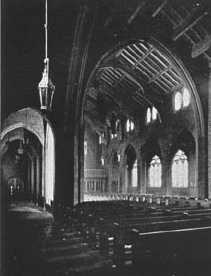
These words have also a local association. They are the ones an the monument at the grave of the late Rev. E. A. Casey in Calvary Cemetery, who was pastor of this parish until 1916 and much beloved by the flock. He
For the rest of the book go to:
| HOME | DOGTOWN |
| Bibliography | Oral history | Recorded history | Photos |
| YOUR page | External links | Walking Tour |